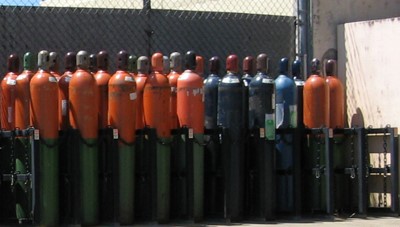Cylinder Safety
Cylinders (also known as “gas bottles”) should be handled only by trained personnel.
Cylinders should only be transported when secured to purpose-designed carts and only with the protective cap securely installed.
Cylinders should be secured from tipping over by holders or restraints designed for such service. Double cylinder restraints (high and low) should be installed in a seismically active area.
Cylinders in the laboratory should be equipped with a pressure regulator designed for hydrogen and marked for its maximum cylinder pressure.
Regulators should be equipped with two gauges, installed to show both the cylinder/inlet pressure and the outlet pressure.
Where the source cylinder is outside the lab, a regulator and gauge should be installed at or near the point of use.
A compressed gas cylinder is considered to be "in use" if it is under the following conditions:
- Connected through a regulator to deliver hydrogen gas to a laboratory operation.
- Connected to a manifold being used to deliver hydrogen gas to a laboratory operation.
- A single cylinder secured alongside the primary cylinder as the reserve cylinder.
Cylinders that are not "in use" should be stored at a safe location outside the lab.
Recommendations for outdoor cylinder storage include:
- Hydrogen cylinders located outdoors should not be installed within 3 m (~ 10 feet) of windows, doors, or other building openings, or within 15m (~ 49 feet) of ventilation intakes.
- Storage areas should have a minimum of 25% of the perimeter open to the atmosphere. This open space can incorporate chain-link fence, lattice construction, open block, or similar materials for its full height and width. See NFPA 2 for specific guidance.
- Storage areas should be kept clear of dry vegetation and combustible materials.
- Cylinders stored outside should not be placed on the ground or on surfaces where water can accumulate.
- Storage areas should be provided with physical protection from vehicle damage.
- Storage should comply with local fire and building codes and storm water regulations for property line setback, threshold storage amounts, and berm requirements.
- Revise hazardous materials storage documents and file with local response authorities for any significant change in hydrogen or other hazardous materials storage.
- Post "NO SMOKING WITHIN 25 FEET" signs in gas cylinder storage areas.
References
CGA P-1, Safe Handling of Compressed Gases in Containers, Edition 11, August 2008.
LLNL's web-based training "DOE Hydrogen Safety". Module 3 - Pressure Safety (HS5094-DOEW).
For more good practices related to labeling, see "Gas Cylinder Safety Guidelines", prepared by Iowa State University Environmental Health & Safety, Ames Laboratory Environment, Safety, Health & Assurance, August 1997. (pdf, 95 kb)
NFPA 45, Standard on Fire Protection for Laboratories Using Chemicals
NFPA 55, Compressed Gases and Cryogenic Fluids Code


